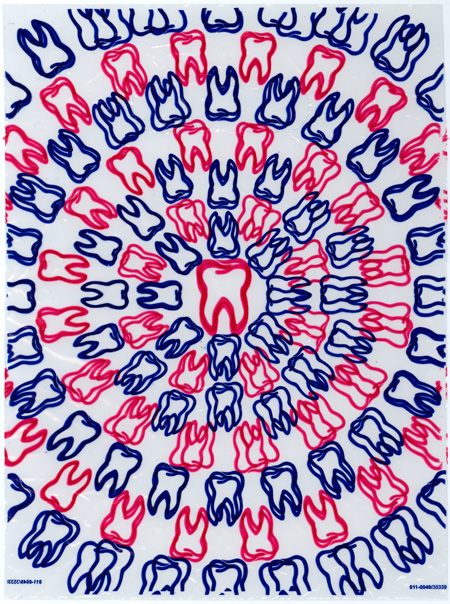I have previously written about troublesome Ginko trees on the University of Iowa campus, and how those nuisance trees were removed. But I was astonished when I walked past the site a few weeks ago, they planted new Ginko trees in the very same spots. It appears they planted male trees, so I guess this eliminates all the problems with the old female trees and their smelly seed pods. In a few years, the trees will mature and look just like they used to, without the disadvantages.

Turing Fest
A minor storm has erupted in comments for an article I posted long ago, thanks to a link from
Andrew Orlowski
at El Reg. He unburied an article I wrote almost a year ago, an essay about DRM and the Church-Turing Thesis. I am still answering comments as they arrive, so I thought I should put a note here, to alert people that all the fun doesn’t necessarily happen at the top of the blog.
Turing’s math papers have always fascinated me, but everyone seems to have their own interpretation. I try to see it at its most fundamental. I remember seeing an article many years ago, describing the simplest possible Turing Machine. It consisted of a strip of paper and some flat stones that were white on one side, black on the other. The stones represented one bit, on or off. It was suggested that you use a roll of toilet paper, as it was conveniently marked in squares, one for each bit. The human operator flipped the stones and moved the strip of paper left and right, according to the algorithm. It was essentially a cellular automaton in 1 dimension.
And that’s how I think Turing saw these problems. I am particularly fascinated by his papers on Morphogenesis, analyzing the spotted patterns in animal fur, and the variegation patterns in plants. Turing conceptualized the growth of the pattern as a 2 dimensional cellular automaton. But Turing always wanted everything to be written as functions, he considered a function as a fundamental unit of computing on a Turing Machine. If it’s a function, it runs to completion, if it’s not a function, it might be Turing-Incomplete and be incomputable.
Turing’s dense forests of functions are way over my head. I wonder if there are even a handful of people who fully understand them. The papers I read that introduced me Turing’s morphogenetic pattern functions admitted they barely scratched the surface.
The Militarization of Everyday Life
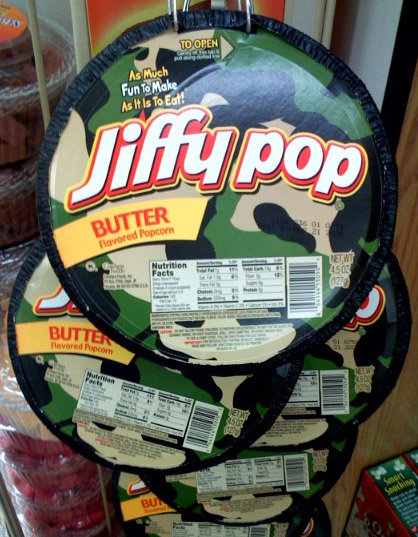
Uniball Signo Bit 0.18mm Pen
Uniball Signo bit, 0.18mm pen, pen, pen review
Lately bloggers have been going crazy for new Japanese pens. Online vendors started importing Japanese pens so now they’re easy to get, so everyone is debating which pen is best for their purposes. Dan Sanderson over at BrainLog wrote about how he accidentally ordered a Uniball Signo Bit 0.18mm gel pen instead of the 0.28mm pen he wanted. I jokingly told him I’ve been dying to test the 0.18mm pens so if he wanted to get rid of it, I’d take it off his hands. So he sent it to me, and I’ve been playing around with it.

I think this is a great little pen, as long as you know what it’s designed for. There’s a competition amongst Japanese pen manufacturers to produce a pen with the finest tip, and the 0.18mm models are the latest and most popular products. They are popular with Japanese schoolkids, they pass notes to each other written in very tiny writing, so their eyeglass-wearing teachers can’t read them. And I immediately noticed this effect, I not only have to wear my close-vision glasses to read what I write, I have to wear my glasses just to see what I’m writing.
I’m more of an aficionado of Japanese mechanical pencils, and I’ve tested out extremely fine-point pencils before. They’re commonly used in drafting, but a 0.25mm lead is too fragile for everyday use, it breaks too easily. So I generally use a 0.5mm pencil like the Uniball Logo II 0.5mm. But a 0.25mm pencil is exceptionally useful for making tiny notes inline above a text, like furigana.
Dan described using the 0.18mm pen as like scratching the point of a pin across the paper, except it leaves ink behind. And that’s part of the problem with tiny pens and pencils, the tip is so small, it can drag and catch on the fiber of the paper. The gel ink is designed to alleviate this problem somewhat, but it still works better on smooth, glossy paper. Most Japanese notebook paper is somewhat finer quality than US paper, so I guess this is less of a problem in Japan. I have a Japanese college ruled notebook, so I tested it out, and you can see in this enlargement, it’s no problem to write two lines in the same vertical space you’d normally write one line.
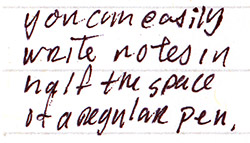
Part of the problem in using a pen this small is that to write small, you must use exceptionally small muscle movements. This gives your tiny handwriting a shaky, unclear look. I have terrible handwriting anyway (as you can see from my sloppy sample above) but at even smaller sizes, it gets much worse. My Japanese handwriting is a little better, so I thought I’d try a tiny “invisible” note. It wasn’t easy, it took me a few tries to write legibly at this size, so here’s an example, it says “yomeru ka” (“can you read it?”) and I’ve reproduced it at actual size, and highly enlarged. I definitely can not read the original without my eyeglasses.

You can use this enlargement for graphical effects. There’s an old graphic artist’s trick of writing extremely small and enlarging it dramatically. This gives the text an interesting, rough texture from the ink absorbing randomly into the paper fibers. I tried it out by writing my blog’s title, I drew a “blueline,” it’s a special color of blue that can be easily removed from the final scan, but provides a guideline to keep your text straight. But this 0.18mm pen writes so small, the height of the text is barely as wide as the blueline.

Well that’s a pleasant effect, but a little bit too blobby for practical use. Maybe if I wrote on smoother paper, it would look nicer. But my handwriting is so poor, I’m unlikely to improve on it. And there’s the problem with this 0.18mm pen, it magnifies all the flaws in your writing, you have to wield the pen with exceptional skill. I’d rather use a small mechanical pencil, at least I can erase and redo it if I make a sloppy mistake. And I make lots of mistakes.
Ultimately, I can’t recommend this 0.18mm pen for general use, it is rather specialized, but it is very good at the job it is intended for. The 0.28mm version might be better for general writing, but I don’t have one to test, and some reviewers have complained that even the 0.38mm version is too fine. But if you need to write tiny notes, perhaps margin notes in a book, or furigana, this pen is the best I’ve ever used.
Is this the ultimate limit of pen technology? Of course not, there are finer pens like the Rapidograph 6×0 0.13mm pen, but it’s a drafting pen, it clogs easily and requires constant maintenance. The Uniball gel ballpoint pens don’t require any maintenance. So I am sure that smaller, finer ballpoints will be produced, I’ve already heard rumors of a 0.125mm pen. But just how fine a line do you really need? The 0.18mm is already so fine it is almost invisible.
Test Sheet
Most painters have a little spot next to their artwork to smear paint around and test their brush before applying it directly to the artwork. Here is the newspaper I used in my current watercolor painting setup, you can click on the picture for a larger view.
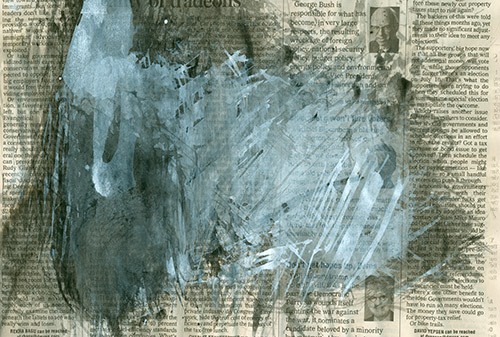
I used to oil paint with my canvas attached to the wall, so I used to wipe my brush right on the wall next to the painting. Here’s a photo of what that looks like. It used to annoy me terribly when people would visit my studio and see my paintings in progress, they would be completely indifferent to my work, but they’d go up to the smears on the wall and say, “ooh, what is that?”
But lately I’ve begun to see what attracts people to these smears. It’s an accidental painting done with absolutely no painting intention. It’s just a test sheet to see how my brush is loaded and how dark and transparent the pigment is, it’s applied over previous test brushstrokes in roughly the same layering as my current painting. So it contains many of the same decisions I make in my current painting, but completely stripped of any deliberate brushwork or imagery. If you think about it, that’s quite Postmodernist (especially considering they just end up in the trash).
I remember seeing a video of Chinese students during the Tiananmen Square protests, painting banners with big brushes and sumi ink. They had a room full of big tables covered with fabric and large posterboards, and at the end of each table were sheets of newspapers, covered with black ink. Each sheet of paper was curled up like a little bowl. Sumi ink is thick and full of resin, so once the sheet was covered in ink and dried, it formed a waterproof bowl, and the students would fill them up with ink. I thought that was pretty clever, but I prefer using a ceramic dish.
BlogTV Japan: Okinawa Halloween Boogeyman
BlogTV is back on the air with a strange Halloween festival in Japan. Well actually, the festival in September, but I thought the creepy theme was appropriate for the Halloween season. This video is 5min 17sec and entirely in Japanese, but it will be fairly obvious what’s happening despite any language barrier.
FujiTV dispatches a reporter to investigate a strange festival on a remote island of Miyakojima, far down the Okinawan island chain. Miyakojima is closer to Taiwan than Tokyo, traveling there takes 17 hours on a ferry. Our intrepid reporter gets off the boat and walks toward the island village. A couple of kilometers from town, some guys are milling about. He asks what’s up and they tell him, it’s time for the Pantou Festival! They’re weaving straw and fibers, cutting thick mats from local vines, and making the Pantou costumes. But the primary ingredient of the Pantou costume is mud. So they’re digging a big hole, stirring up the dark black mud, and mixing it with sticky leaves and straw. Of course a scary wooden mask of an ancient design is required to complete the costume. The reporter leaves the Pantou people to prepare and walks towards town.
At the edge of town, a children are waiting, Pantou is coming this way! They spot the three dark figures walking down the road, they’re dressed in leaves, straw, and mud, with a crazy sprig of leaves and branches coming out of their head like a horn. And now we see what the festival’s about, Panto chases after the kids and smears them with mud. Everyone runs in terror, trying not to get smeared in the sticky mud. But Pantou catches them and gives them a big smear right in the face! Apparently this is some sort of harvest ritual, smearing the children with earth will ensure their health and prosperity, and that of the whole village.
But our reporter has traveled a long way to see this festival, so he gets the full treatment. All three Pantou men gang up on him and sit on him, so he’s covered in mud from head to toe. Well at least now he doesn’t have to worry about getting caught, once you’re muddy, Pantou will leave you alone, his job is done.
Some of the little children are too young to be chased, so their mothers offer them up to Pantou, some of them he gives a muddy embrace, some he just gently daubs on the cheek, some of them, pow! right in the kisser. Mom gets a little daub of mud too. The looks on some of the kids faces are just priceless. One little kid is crying, even though he’s barely muddy at all. Some of the kids are just terrified.
But Pantou is not just after the kids and their mothers. Panto makes a house call and rolls around in the entryway, gettting mud all over the floor. I don’t know how the old guy was chosen for a visit by Pantou, but he seems to be taking it in stride. At least there’s not too much of a mess to clean up. [Update: I found out that newly constructed houses are visited by Pantou, I guess it is a sort of initiation.]
But to pass on a Japanese tradition, it must be handed down in the family. One of the Panto actors has a new child, this is its first opportunity to meet the demonic mud man. He gently extends a muddy finger, and wipes it lightly on his child’s face. And then again, a little less gently, on his wife’s face.
The Pantou men chase after the villagers for two days, with endless replenishment of buckets of mud, seeking to leave noone unbesmirched. The festival winds down at sunset, as Pantou chases down the last stragglers. And then Pantou disappears into the night, until the next year’s festival.
Eye
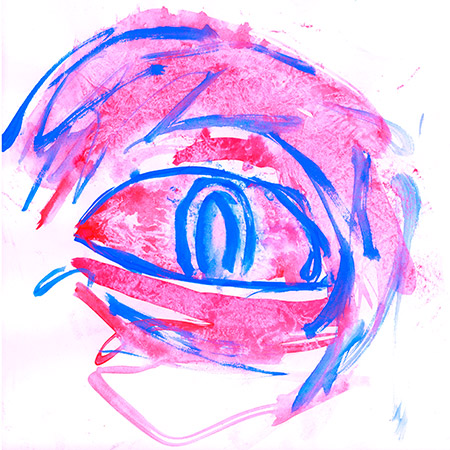
I went through some old work and I found a watercolor painting that was particularly amusing. I don’t remember painting this, but I must have done it around 1992. I remember I took a drawing class and was assigned to do endless studies of cranial anatomy and the eye in particular. It’s anatomically accurate enough that I can tell it’s my own right eye. I must have been bored with the assignment, staring at myself in the mirror, and decided to spice things up a little. You can’t tell from the scan, but the pigments are intensely bright Day-Glo fluorescent magenta and cyan. I wish you could see the original, it’s almost too bright to look at.
Help, my iPhone Won’t Ring!
Apple blogs had an outpouring of derision when a prominent, self-declared technology expert could not figure out why his iPhone stopped ringing. Of course this was because he’d flipped the Silence Ringer switch. John Gruber rushed to his defense with this comment:
It’s easy to laugh at, but I think it’s actually a non-obvious design. There’s no icon or visual indication as to what that switch does. You do get a small jolt of vibration when it’s engaged, but that doesn’t naturally imply “silent mode” to me. (Update: Yes, there’s also an on-screen icon, but that only helps if you toggle it while the screen is on.)
But the icon will also appear if your screen is off. If your iPhone is sleeping and has been inactive more than 1 minute, flipping the Silence Ringer switch will turn on the screen, and the big icon of a bell with a slash through it will appear. However, if your iPhone is sleeping but has been used within the last 1 minute, you only get the buzz of tactile feedback, indicating the phone is in vibrate mode. So the only possible way to miss the visual feedback of the Silence Ringer icon is if you turn off your iPhone and then immediately start flipping the switch.
But to me, the bigger question is, what kind of idiot would buy a $400 phone and not know how to operate the buttons? There are only 4 hardware buttons on the iPhone. Apple went to considerable pains to make the Silence Ringer switch functions as obvious as possible, even to technology experts.
Update: Comments Disabled. I have blocked further comments on this subject, I almost never do this. I continue to receive a steady stream of comments on this post, it has become unmanageable. It was not my intention for this brief article to become the #1 Google search result for “iPhone won’t ring.” It was not my intention to sneer at users who could not figure out the problem. It was my intention to sneer at one pompous software “expert” who could not figure it out (I have sworn never to mention him by name on this blog, but follow the first link in this story and you will figure it out). I am gratified by the positive comments from readers who discovered here the solution to their problems. I have ignored the negative comments from people who were insulted. Thank you to all who took interest (and those who continue to discover this article).
Tan Lines
Summer is over, and all I have to show for it are these stupid tan lines.
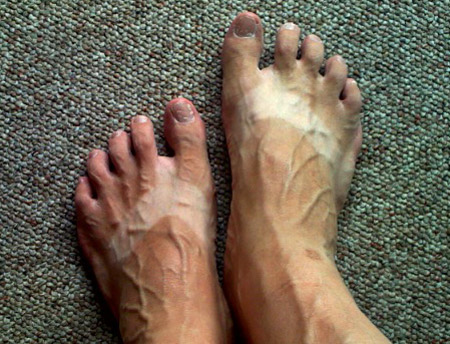
Toothache
I went to the dentist the other day, I had my biannual checkup. I don’t recall when I suddenly switched from an annual to a biannual schedule, it’s definitely twice as expensive. But this appointment was good timing, I have a toothache.
The assistant took an x-ray of my sore molar, the same molar the dentist filled 6 months ago. I figured it was just sensitivity to the filling, but that should have faded over time, this was getting worse. Maybe I pulled the filling loose. But the dentist says he can find nothing wrong with my tooth. It may have a crack which would be almost impossible to see on an x-ray. If it persists, I can go see an endodontist, which will surely cost a packet of money. The dentist said I could wait and see if it would clear up, or get worse, it’s not showing any signs it needs urgent intervention.
As I left the dentist, they gave me a little bag with a toothbrush, some toothpaste, and some floss. I didn’t look too closely at the bag, it had a cute little tooth pattern on it. But then I got the bag home, emptied it out and set it on a white surface. The bag was transparent, I could see the pattern through both sides, and suddenly my toothache seemed a lot worse.
